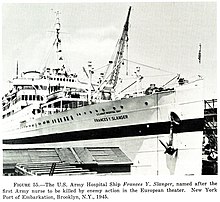Saturnia (ship)
|
The Saturnia as a hospital ship
|
||||||||||||||||||||||
|
||||||||||||||||||||||
|
||||||||||||||||||||||
|
||||||||||||||||||||||
|
||||||||||||||||||||||
|
||||||||||||||||||||||
The Saturnia was a transatlantic passenger ship put into service in 1927 by the Italian shipping company Cosulich Line with her home port in Trieste . In the final phase of World War II , the ship was called Frances Y. Slanger and served as a hospital ship for the United States. Back in Italian hands after the war, it was decommissioned in 1965 and scrapped in the same year.
The ship
The 23,940 GRT motor ship Saturnia was built at the Cantiere Navale Triestino shipyard in Monfalcone, Italy, and was launched on December 29, 1925. She was the sister ship of the 23,970 GRT Vulcania , which was launched a year later (December 19, 1926) at the same shipyard. The two ocean liner had a chimney, two masts and two propellers and were built for the Cosulich Società Triestina di Navigazione (usually called Cosulich Line ) based in Trieste . This was the successor company of the former Austrian shipping company Austro-Americana, which came into Italian hands with the handover of Trieste to Italy after the First World War.
The Saturnia was 191.9 meters long, 24.3 meters wide and could reach a speed of 19 knots. The passenger accommodations were designed for 305 passengers in first class, 460 in second class, 310 in classe intermedia ( middle class ) and 700 in third class. The ship was built for passenger traffic from Italy to New York and South America . She and the Vulcania were among the largest motor ships in the world when they entered service in the mid-1920s.
On September 21, 1927, the Saturnia left Trieste on her maiden voyage to South America via Naples and Marseille . On February 1, 1928, she left for her first Atlantic crossing to New York. On January 1, 1937, the new company Italia Società di Navigazione , known in the English-speaking world as Italian Line , was founded in Genoa and took over the holdings of the state-owned shipping company Italia Flotte Riunite . This again emerged in 1932 from the merger of the previously independent Italian shipping companies Navigazione Generale Italiana , Lloyd Sabaudo and Cosulich Line. The Saturnia thus came to Italia Società di Navigazione in 1937.
Interned in New York Harbor in May 1940 , the ship was confiscated by the United States in December 1941 and converted into a hospital ship in 1945 . On February 13, 1945, the ship under the name Frances Y. Slanger was put into service as a hospital ship for the United States Navy . It was named after Frances Y. Slanger (1913–1944), an American field nurse who was killed in an artillery attack by the German Wehrmacht on October 21, 1944 in Elsenborn, Belgium . She was the first American nurse to die of enemy action in Europe during World War II.
In November 1946 the ship was returned to Italy and renamed Saturnia again. It was completely overhauled and from then on it was able to carry 240 passengers in first class, 270 in second class and 860 in tourist class. On January 20, 1947, she embarked on her first post-war voyage from Genoa to New York via Naples. Her last journey on this route began on October 3, 1955. Then the Saturnia was put on the Mediterranean-USA-Canada route and ran to Halifax , Boston and New York in North America . On March 7, 1965, she set sail for her very last voyage across the Atlantic. On October 7 of the same year she arrived in La Spezia , where the demolition began shortly afterwards.
Web links
- Summary ship data in The Ships List (approximately in the middle)

